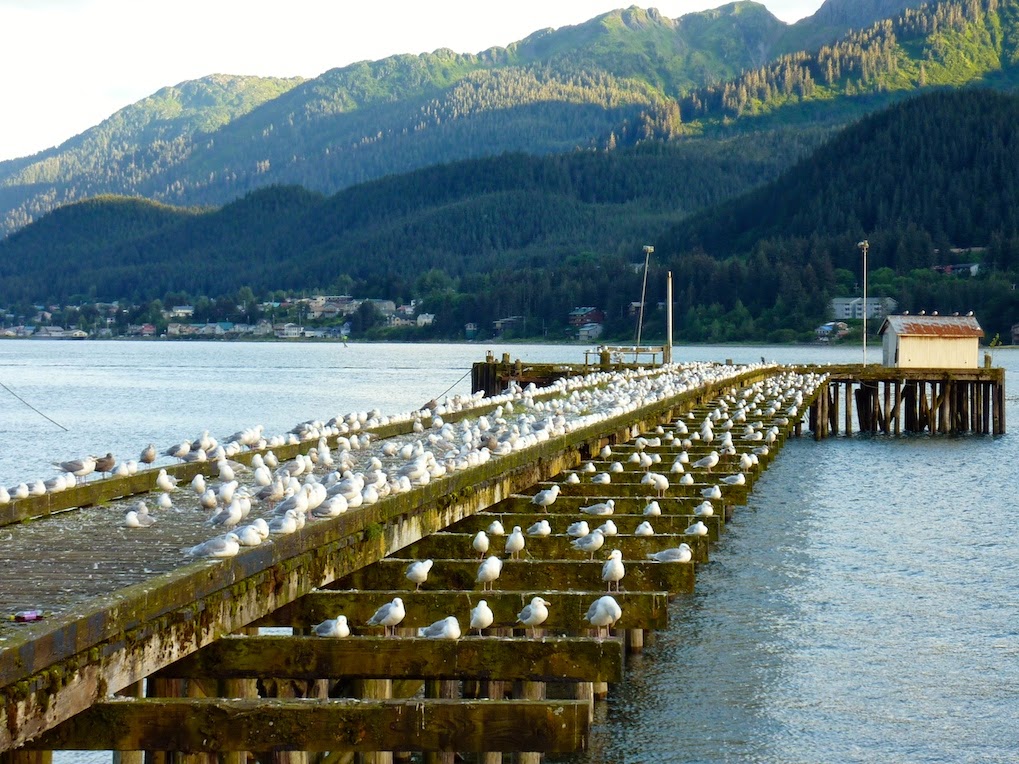 |
| Creek Street, Ketchikan |
 |
| Salmon catch the Sun, side by side |
Apparently, these salmon were Pinks; each variety runs on its own schedule; King and Sockeye run earlier. There are five varieties of Pacific Salmon; the locals use a memory jogger to remember them on one hand:
Thumb
|
Chum or dog
|
Forefinger
|
Sockeye (poke yer eye) or red
|
Index
(longest)
|
King or Chinook
|
Ring
Finger
|
Silver or Coho
|
Pinky
|
Pink or Humpy
|
 |
| Salmon-case Stencils |
 |
| Dolly Arthur’s Bedroom |
 As suggested by our Haida friends on the
ferry, we caught the bus out to Saxman Native Village on the outskirts of town.
The restoration of totem poles taken from uninhabited villages has made this a
centre for totem carving. The world’s largest concentration of totem poles lies
in this area. We visited a carving house and talked to two young sculptors
about traditional paints: “Each coloured rock is ground to a fine powder then mixed
with salmon eggs and saliva – you chew the eggs in your mouth then spit the
juice through your teeth into the bowl of powder. Your teeth filter the liquid,
leaving the skin around the eggs in your mouth.” We didn’t try it!
As suggested by our Haida friends on the
ferry, we caught the bus out to Saxman Native Village on the outskirts of town.
The restoration of totem poles taken from uninhabited villages has made this a
centre for totem carving. The world’s largest concentration of totem poles lies
in this area. We visited a carving house and talked to two young sculptors
about traditional paints: “Each coloured rock is ground to a fine powder then mixed
with salmon eggs and saliva – you chew the eggs in your mouth then spit the
juice through your teeth into the bowl of powder. Your teeth filter the liquid,
leaving the skin around the eggs in your mouth.” We didn’t try it!
On our travels, we asked for a good placeto eat; Bar Harbor was recommended and indeed it was good: “You go through the
tunnel beside your hotel and walk a little way and it’s right there,” she’d
said. Well, ‘a little way’ turned out to be a couple of miles… and as we set
out it started to rain. We had no rain gear and as we walked the rain grew
heavier. Soon we were so drenched that we stopped at a hotel. The receptionist
laughed as she handed us towels and called a taxi. But, the food was delicious.
The rain had stopped so we caught a bus back (cabs can take a while) – the next
stop was at a fish processing plant and the shift was just ending. A guy got on
and sat next to us – he smelled very fishy. It was then that I noticed the
sign: “No-one must bring offensive odors onto the bus.”
 |
| New Eddystone Rock |
We got back just in time to eat in the
hotel and catch a cab back to the ferry – it was the same driver that had
brought us. That’s Alaska for you!
Next week our trip ends in Prince Rupert, BC
Text in italics indicates a link to more info
 |
| Haida Thunderbird Mask |
Text in italics indicates a link to more info




















